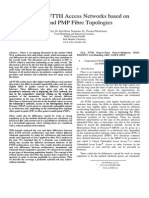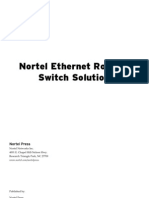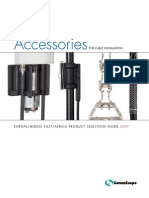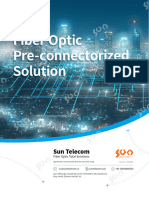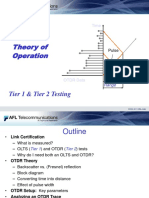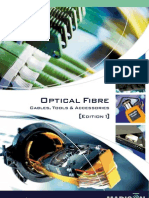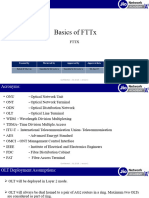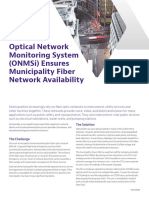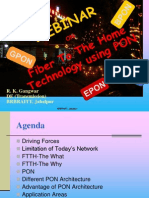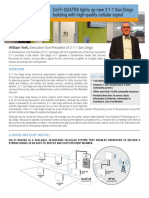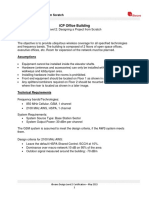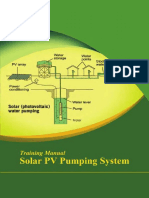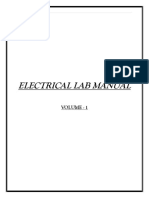FCGA Definition of Terms - Revisions2017 PDF
FCGA Definition of Terms - Revisions2017 PDF
Uploaded by
Diego ZABALACopyright:
Available Formats
FCGA Definition of Terms - Revisions2017 PDF
FCGA Definition of Terms - Revisions2017 PDF
Uploaded by
Diego ZABALAOriginal Title
Copyright
Available Formats
Share this document
Did you find this document useful?
Is this content inappropriate?
Copyright:
Available Formats
FCGA Definition of Terms - Revisions2017 PDF
FCGA Definition of Terms - Revisions2017 PDF
Uploaded by
Diego ZABALACopyright:
Available Formats
FCGA - Definition of Terms
Version 6.0 - September 2017
Powered by FCGA
About FCGA:
The FTTH Council Global Alliance (FCGA) is the platform for cooperation of the four global FTTH Councils and the
Fiber Broadband Association. The organization share a common goal: the acceleration of fiber to the home
adoption. The five entities act as powerful and independent organizations in their specific market. This regional
focus gives the FCGA a special strength to adapt its activities to the particular market situation in their area.
The FTTH Council Global Alliance ensures that those regional efforts are combined with the power of global
cooperation. Within the FCGA the organizations exchange studies, information and latest market developments.
Contact FCGA:
FTTH Council Europe: info@ftthcouncil.eu – www.ftthcouncil.eu
Fiber Broadband Association: infofiber@fiberbroadband.org – www.fiberbroadband.org
FTTH Council APAC: info@ftthcouncilap.org – www.ftthcouncilap.org
Fiber Broadband Association LATAM Chapter: latamchapter@fiberbroadband.org – www.fiberbroadband.org/latamchapter
FTTH Council MENA: info@ftthcouncilmena.org – www.ftthcouncilmena.org
FTTH Council Africa: juanita@ftthcouncilafrica.com – www.ftthcouncilafrica.com
FCGA - Definition of Terms (V.6.0 - Revision Date: September 2017) Page 1 of 9
INTRODUCTION
The mission of all the organizations in North America, Europe, Asia Pacific, LATAM, Middle
East & North Africa and Africa includes the communication to stakeholders in our respective
regions of the extent of usage of Fiber throughout the world and forecasting the growth of FTTH
and Fiber Technology.
This task has been made difficult by the proliferation of terms and acronyms while no doubt
useful to individual organizations for their specific purposes, lack precise definitions.
This is of particular concern when different research organizations choose their own definitions
when conducting research. As a consequence it becomes impossible to compare the research
on Fiber deployment (to-the-home, business or endpoint) between different regions, or between
different studies of the same region.
This document defines the terms used by all the organizations in the FCGA (North America,
LATAM, Europe, Asia Pacific, Middle East & North Africa, Africa).
It is common in the industry to refer to systems that bring optical fiber close to the subscriber
Premises as FTTx. FTTx is a generic term where optical fiber replaces or supplements copper
in the access network. This document explicitly defines FTTH and FTTB in which the fiber
terminates at the subscriber's home or building.
This document specifically aims to reduce the terms used to a subset that are well defined,
adequate and useful.
However, to be successful, the terms defined in this document must be used frequently and
consistently. Thus, all members of the organization and other stakeholders such as operators,
analysts, journalists, and government and regulatory staff are encouraged to use these terms as
the well-defined vocabulary that underpin the more general expressions.
With regards to market study, however, in order to compare the research conducted by different
organizations in the same or different regions, it is essential that these terms are used and not
interchanged with other. The FCGA will assure that the definitions of this document will be used
for their market research.
FCGA - Definition of Terms (V.6.0 - Revision Date: September 2017) Page 2 of 9
ACKNOWLEDGEMENTS
The Definition of Terms has been produced by the FCGA and depends on the cooperation of
the five global organizations. We thank the following individuals for their time, effort and
contributions, and acknowledge their original material for the FCGA – Definition of Terms
documentation.
Sixth edition
Juanita Clark, Andre Hoffmann, Chris Nel FTTH Council Africa, Heather B. Gold Fiber
Broadband Association, Jan Schindler FTTH Council Europe, H. Munasir Choudhury FTTH
Council Asia Pacific, Christine Beylouni Middle East & North Africa.
THE TERMS
Supporting definitions:
1
“Premises” is a home or place of business. In a multi-dwelling unit each apartment is
therefore counted as one Premises.
“Subscriber” is a Premises that is connected 2 to a network and uses at least one
service on this connection under a commercial contract.
“Homes Passed” is the potential number of Premises which a Service Provider has
capability to connect to an FTTH/FTTB network in a service area. Typically new service
activation will require the installation and/or connection of a drop cable from the homes
passed point (e.g. fiber-pedestal, manhole, chamber, utility-pole) to the Premises, and
the installation of subscriber Premises equipment at the Premises. This definition
excludes Premises that cannot be connected without further installation of substantial
fibre plant such as feeder and distribution cables (fiber) to reach the area in which a
potential new subscriber is located.
“Homes Connected” is the number of Premises which are connected to a network and
are already subscribers or can be turned into a subscriber without further installation
work.
1
Multi-tenant unit in some countries.
2
Implies a service termination point.
FCGA - Definition of Terms (V.6.0 - Revision Date: September 2017) Page 3 of 9
“Penetration Rate” equals “Subscribers” divided by the number of Premises in a
service area.3
“Connect Rate” equals “Homes Connected” divided by “Homes Passed”.
“Take Rate” equals “Subscribers” divided by “Homes Passed”.4
Fiber-to-the-Home5 (FTTH)
“Fiber to the Home” is defined as an access network architecture in which the
connection to the subscriber’s Premises is Optical Fiber.
The fiber optic communications path is terminated on or inside the Premises for the
purpose of carrying communication services to a single subscriber.
In order to be classified as FTTH, the access fiber must cross the subscriber’s Premises
boundary and terminate
• inside the Premises, or
• on an external wall of the subscriber’s Premises
FTTH may enable just one service, but generally enables several such as data, voice
and video and potentially from multiple service providers.
This FTTH definition excludes architectures where the optical fiber terminates in a public
or private space before reaching the Premises and where the access path continues to
the subscriber over a physical medium other than optical fiber (for example copper
loops, power cables, wireless and/or coax).
Fiber-to-the-Building (FTTB) 6
“Fiber to the Building” is defined as an access network architecture in which the final
connection to the subscriber’s Premises.
The fiber optic communications path is terminated within the building for the purpose of
carrying communication services for a single building with potentially multiple
subscribers.
3
In the FTTH Global Ranking, the service area is defined as the country / economy.
4
It is expressed as a percentage. “Take rates” can be based on each type of service, for
example, data take rates, video take rates, and voice take rates, or triple/quadruple services take
rates.
5
Important note: This document uses the American English spelling “fiber”. The FTTH
Council Europe uses the British English spelling “fibre” in their communication. This is seen
to be the same.
FCGA - Definition of Terms (V.6.0 - Revision Date: September 2017) Page 4 of 9
It is implicit that in order to be classified as FTTB, the fiber must at least
• enter the building, or
• terminate on an external wall of the building, or
FTTB may enable just one service, but generally enables several such as data, voice
and video and potentially from multiple service providers.
This FTTB definition excludes architectures where the optical fiber cable terminates in a
public space away from an external wall of one building (for example an operator’s
street-side cabinet) and where the access path continues to the building over a physical
medium other than optical fiber (for example copper loops, power cables, wireless
and/or coax).
6
FTTB construction is a transitional form commonly used as a means to deliver services to
existing buildings in conjunction with associated FTTH construction (for example for new
buildings). By introducing fiber cables from the fiber termination point to the Premises
FTTB can be subsequently converted to full FTTH. Such a conversion is desirable as FTTH
provides better capacity and longevity than FTTB.
FCGA - Definition of Terms (V.6.0 - Revision Date: September 2017) Page 5 of 9
SOME MORE TERMS
Network Topology
The fibre plant connects the operator’s Premises and subscribers’ Premises. It can be
deployed in the following different topologies:
“Point-to-Point” (P2P7, Pt-Pt, or PtP) fibre plant provides optical fibre paths from a
communication node located outside of the building to a single Premises - such that the
optical paths are dedicated to traffic to and from this single location.
“Point-to-Multipoint” (P2MP) fibre plant provides branching optical fiber paths from a
communication node to more than one Premises (or building) - such that a portion of the
optical paths are shared by traffic to and from multiple Premises. This branching is
typically realized through power or wavelength splitters or active switches.
“Ring” fibre plant provides a sequence of optical fiber paths in a closed loop that
connects a series of communication nodes.
Note that from these definitions it is not possible to identify the access protocol used
over the fibre plant.
Technology
Ethernet T(W)DM PON WDM-PON
(GPON, EPON, RFoG, (wavelength per
10GEPON, XG-PON1, customer)
NG-PON2)
Topology Point-to-Point Ethernet P2P PON P2P N.A.
Point-to- Active PON P2MP WDM PON
Multipoint Ethernet
7
The abbreviation P2P is sometimes also used to describe peer-to-peer-networks, e.g. to exchange files
over the internet. This P2P is not related to the point-to-point definition in this document economy.
FCGA - Definition of Terms (V.6.0 - Revision Date: September 2017) Page 6 of 9
Relationship between topologies and technologies (rings have been omitted).
It is possible for a network to be built such that a common fibre plant can include a mix of
different topologies or be re-configured over time to support different topologies, to allow
for mixed user categories, to allow access diversity for reliability, and for future flexibility
and network longevity.
Feeder Network
It is the fiber network deployed from the Central office OLT to the first branching point in
the fibre plant.
Distribution Network
It is the fiber network deployed from first branching point to the curb connection point.
Drop Cable
It is the fiber cable connecting the subscriber to the curb connection point and into the
network.
Access Protocol
Access Protocols are the methods of communication used by the equipment located at
the communication nodes and at the subscribers’ Premises (or buildings) to ensure
reliable and effective transmission and reception of information over the optical paths.
These protocols are defined in detail by the standards organizations that have created
them, and are recognized and implemented by manufacturers around the world.
The Access Protocols in use today for FTTH Networks and the optical portion of FTTB
Networks are:
“Ethernet” defined in IEEE 802.3
“EPON” defined as Ethernet PON in IEEE802.3 (Note that the expression
Gigabit EPON is synonymous with EPON.).
“10GEPON” defined in IEEE802.3av is an upgrade of EPON to carry 10Gbps
downstream and 1 or 10Gbps upstream.
“B-PON” defined as Broadband PON in ITU-T Recommendation G.983 (largely
obsolete).
“G-PON” defined as Gigabit PON in ITU-T Recommendation G.984
FCGA - Definition of Terms (V.6.0 - Revision Date: September 2017) Page 7 of 9
“XG-PON1” defined as 10G PON in ITU-T Recommendation G.987
“NG-PON2” defined as TWDM PON in ITU-T Recommendation G.989
“OTHER” access protocols such as proprietary or pre-standard access protocols may
be noted for the purpose of completeness in research.
Network Usage
FTTH/FTTB networks may be dedicated to the services of a single retail or wholesale
service provider, or made available to many retail service providers, who may connect to
the network at the packet, wavelength or physical layer.
“Exclusive Access” refers to the situation where a single retail service provider (who
may or may not be the network operator) has exclusive use of the FTTH network. Such
a service provider is called “vertically integrated”.
“Open Access (Packet)”8 refers to the situation where multiple retail service providers
may use the FTTH network on an equable base by connecting at a packet layer
interface and compete to offer their services to end users. This packet layer interface
may be implemented on layer 2 (Ethernet) or 3 (IP).
“Open Access (Layer2)”9 refers to the situation where multiple retail service providers
may use the FTTH network on an equable base by connecting at a layer 2 Ethernet
interface from OLT or an aggregation point and compete to offer their services to end
users.
“Open Access (Layer3)”10 refers to the situation where multiple retail service providers
may use the FTTH network on an equable base by connecting at a layer 3 IP or MPLS
layer interface from OLT or an aggregation point and compete to offer their services to
end users.
8
In many cases this is also called “Bitstream Open Access”.
9
In many cases this is also called “Bitstream Open Access”.
10
In many cases this is also called “Bitstream Open Access”.
FCGA - Definition of Terms (V.6.0 - Revision Date: September 2017) Page 8 of 9
“Open Access Wavelength/Lambda”11 refers to the situation where multiple retail or
wholesale service providers may use the FTTH network on an equable base by
connecting at a wavelength layer interface and compete to offer their services.
“Open Access Fiber” refers to the situation where multiple retail or wholesale service
providers may use the infrastructure by connecting at a physical layer (dark fiber 12)
interface and compete to offer their services.
“Open Access Duct/Dark Air” refers to the situation where multiple retail or wholesale
service providers may share the use of infrastructure by drawing or blowing their fiber
cables through the shared ducts, and compete to offer their services.
“Open Access Flexibility point” refers to the concentration point where multiple retail
or service providers may connect via their feeder cables and access layer 1 feeder fiber
connectivity to each household. This concentration or flexibility point may be located at
the building or cabinet or ODF.
Open access on multiple layers can be implemented in the same network, e.g., on a
dark fiber level, and on a bitstream level. This is then called “Multilayer Open”.
11
Open Access on a wavelength level was originally planned for WDM-PONs (which have never received
sufficient market traction), but it will become relevant in the context of NG-PON2.
12
Dark Fiber is a strand of fiber which is made available to a provider, without active termination points,
on an exclusive basis.
FCGA - Definition of Terms (V.6.0 - Revision Date: September 2017) Page 9 of 9
You might also like
- Light BrigadeDocument74 pagesLight Brigadepiter100% (1)
- Comparing FTTH Access Networks Based On P2P and PMP Fibre TopologiesDocument9 pagesComparing FTTH Access Networks Based On P2P and PMP Fibre TopologiesWewe SlmNo ratings yet
- 13 5Document5 pages13 5jaiganeshv1991No ratings yet
- June 2014 CFA Examination Admission TicketDocument1 pageJune 2014 CFA Examination Admission TicketVinayak AggarwalNo ratings yet
- Computer Communications and Networks: Springer-Verlag London LTDDocument306 pagesComputer Communications and Networks: Springer-Verlag London LTDNasreedine BelguithNo ratings yet
- NortelDocument110 pagesNortelVijay KumarNo ratings yet
- Research Paper FTTHDocument15 pagesResearch Paper FTTHAlfarid IslamNo ratings yet
- LTE Self-Organising Networks (SON): Network Management Automation for Operational EfficiencyFrom EverandLTE Self-Organising Networks (SON): Network Management Automation for Operational EfficiencySeppo HämäläinenNo ratings yet
- Accessories: Europe/Middle East/Africa Product Selection GuideDocument68 pagesAccessories: Europe/Middle East/Africa Product Selection GuideShiela Monique FajardoNo ratings yet
- TM 2G3G4G Hardware Installation Guide V1.6 PDFDocument150 pagesTM 2G3G4G Hardware Installation Guide V1.6 PDFjacobus_louw4329No ratings yet
- Fujikura - Optical ComponentsDocument42 pagesFujikura - Optical ComponentsSeung-Min LeeNo ratings yet
- Fiber Optic NotesDocument7 pagesFiber Optic NotesAmin JamaludinNo ratings yet
- FTTR T-Tut-Home-2021-1-Pdf-EDocument17 pagesFTTR T-Tut-Home-2021-1-Pdf-EAnges AZONNOUDONo ratings yet
- Bktel FTTH SolutionsDocument9 pagesBktel FTTH SolutionsVivin ViolitaNo ratings yet
- En-Fiber Optic Pre-Connectorized SolutionDocument44 pagesEn-Fiber Optic Pre-Connectorized SolutionbashkimNo ratings yet
- FTTH Handbook - 2014 V6.0Document162 pagesFTTH Handbook - 2014 V6.0hpmducNo ratings yet
- OTDR.-Theory of OperationDocument83 pagesOTDR.-Theory of OperationHugh cab100% (1)
- FO-C&I Booklet V 0.0 25032021Document92 pagesFO-C&I Booklet V 0.0 25032021abera alemayehuNo ratings yet
- MADISON TECH - Optical Fibre Cables, Tools and AcessoriesDocument52 pagesMADISON TECH - Optical Fibre Cables, Tools and AcessoriesnahsirkNo ratings yet
- FTTH SCTE May2010Document92 pagesFTTH SCTE May2010Mustapha BrahimNo ratings yet
- Fiber Access Solution FTTx-PONDocument39 pagesFiber Access Solution FTTx-PONMohamed Shabana100% (1)
- Optec Catalogue PDFDocument98 pagesOptec Catalogue PDFVijay Lakshmipathy0% (1)
- Making Case FTTH Pon Fiber Test Systems Case Studies enDocument2 pagesMaking Case FTTH Pon Fiber Test Systems Case Studies enDan StoicescuNo ratings yet
- ResumeDocument7 pagesResumedpprasad2No ratings yet
- Fiber To The AntennaDocument20 pagesFiber To The AntennaNuno FernandesNo ratings yet
- FTTX Solutions: Mini Fiber Distribution Hub 3000Document5 pagesFTTX Solutions: Mini Fiber Distribution Hub 3000julianNo ratings yet
- Basics of FTTXDocument29 pagesBasics of FTTXVikasNo ratings yet
- Fiber Optic Network Management - The Ultimate GuideDocument15 pagesFiber Optic Network Management - The Ultimate GuideCristi SueNo ratings yet
- LTE/LTE A Interference Coordination For FemtocellsDocument98 pagesLTE/LTE A Interference Coordination For FemtocellsRoy Naldo Nathaniel SihotangNo ratings yet
- Fibra OpticaDocument5 pagesFibra Opticacarlosantunez111No ratings yet
- FTTH ProfileDocument28 pagesFTTH Profilesandeepmishra100% (1)
- Telecom GlossaryDocument206 pagesTelecom GlossaryAshish Mohapatra0% (1)
- TelesomDocument22 pagesTelesomkibaaro1No ratings yet
- Passive Network Design 1Document30 pagesPassive Network Design 1jorgefuriasse100% (1)
- HOW GPON WorkDocument13 pagesHOW GPON WorkHarsh Zaveri100% (1)
- Spatialnet: End-To-End Physical Network Inventory ManagementDocument3 pagesSpatialnet: End-To-End Physical Network Inventory ManagementtalhaNo ratings yet
- Inventory of FTTH in Europe: Press Release, 11 February 2009Document4 pagesInventory of FTTH in Europe: Press Release, 11 February 2009nitsuiNo ratings yet
- FTTX Pon Exfo Guide v5 EngDocument116 pagesFTTX Pon Exfo Guide v5 EngAdesh BandhuNo ratings yet
- Malaysia Rear Seatbelt CampaignDocument7 pagesMalaysia Rear Seatbelt Campaignsathiyaa80% (1)
- The Basics of FTTHDocument36 pagesThe Basics of FTTHFanny Tampubolon100% (1)
- Glosario FTTHDocument34 pagesGlosario FTTHJOSE DANNY SIESQUEN CHAMBERGONo ratings yet
- Televes OLT512 Optical Line TerminalDocument1 pageTeleves OLT512 Optical Line TerminalBastian AtenasNo ratings yet
- JTLCompany ProfileDocument10 pagesJTLCompany ProfilekipronokelongNo ratings yet
- Handbook for Ftth Osp v1 0 (印尼电信ftth-osp作业指南)Document101 pagesHandbook for Ftth Osp v1 0 (印尼电信ftth-osp作业指南)Ananggadhipa Sedyanto Putro100% (1)
- Telecomunications Cabling Specification v5Document77 pagesTelecomunications Cabling Specification v5Tamer Elmaghraby100% (1)
- Measuring Optical Link Loss GA-TN-048-00Document6 pagesMeasuring Optical Link Loss GA-TN-048-00funnyguyguyNo ratings yet
- Fibre To BTSDocument7 pagesFibre To BTSPravesh Kumar Thakur100% (2)
- Mobile Payments and Banking: ©2009 Informa UK LTDDocument12 pagesMobile Payments and Banking: ©2009 Informa UK LTDAzim Ul HaqNo ratings yet
- Fast ConnectDocument9 pagesFast ConnectGustavo100% (1)
- IMaster NCE Optical Resource Assurance APP V100R19C00 User Guide 01Document341 pagesIMaster NCE Optical Resource Assurance APP V100R19C00 User Guide 01VVLNo ratings yet
- Section 6 B2H SOPDocument91 pagesSection 6 B2H SOPDayaram SahNo ratings yet
- Optical Network Monitoring System Onmsi Ensures Municipality Fiber Network Availability Case StudiesDocument2 pagesOptical Network Monitoring System Onmsi Ensures Municipality Fiber Network Availability Case StudiesgagaNo ratings yet
- Laboratory Manual For Copper CablingDocument48 pagesLaboratory Manual For Copper CablingBikash Bhattarai100% (1)
- Fiber Arch For Rural FTTX WPDocument5 pagesFiber Arch For Rural FTTX WPVulpe FlorianNo ratings yet
- 12.5U Central MSAN - 2 Management and Switching Cards PlusDocument2 pages12.5U Central MSAN - 2 Management and Switching Cards PluswirelesssoulNo ratings yet
- FiberplanitDocument4 pagesFiberplanitJoel TorresNo ratings yet
- R. K. Gangwar DE (Transmission) BRBRAITT, JabalpurDocument57 pagesR. K. Gangwar DE (Transmission) BRBRAITT, JabalpurRanjit SinghNo ratings yet
- 420 Mini and Micro Cable Blowing-In DevicesDocument31 pages420 Mini and Micro Cable Blowing-In DevicesKlanac BrčkoNo ratings yet
- Fibreflow CatalogueDocument124 pagesFibreflow CatalogueOmair MustafaNo ratings yet
- Case ElevatorDocument1 pageCase ElevatorDiego ZABALANo ratings yet
- Case Study - Aspley Shopping CentreDocument2 pagesCase Study - Aspley Shopping CentreDiego ZABALANo ratings yet
- Ixd 360v03nu PDFDocument1 pageIxd 360v03nu PDFDiego ZABALANo ratings yet
- Indoor Cellular Coverage: For AerospaceDocument1 pageIndoor Cellular Coverage: For AerospaceDiego ZABALANo ratings yet
- Cel-Fi Quatra: Helps Law Enforcement Agency Solve Cellular Signal Issues Inside Multiple FacilitiesDocument2 pagesCel-Fi Quatra: Helps Law Enforcement Agency Solve Cellular Signal Issues Inside Multiple FacilitiesDiego ZABALANo ratings yet
- Solid Alliance Multi-Operator DasDocument3 pagesSolid Alliance Multi-Operator DasDiego ZABALANo ratings yet
- 80010872Document10 pages80010872Diego ZABALANo ratings yet
- Quatra: Cel-Fi QUATRA Lights Up New 2-1-1 San Diego Building With High-Quality Cellular SignalDocument2 pagesQuatra: Cel-Fi QUATRA Lights Up New 2-1-1 San Diego Building With High-Quality Cellular SignalDiego ZABALANo ratings yet
- Iwh 080VH07NZ PDFDocument1 pageIwh 080VH07NZ PDFDiego ZABALANo ratings yet
- Level 2 DFS WorkshopDocument4 pagesLevel 2 DFS WorkshopDiego ZABALA100% (1)
- Flexcab: Metal Street CabinetDocument2 pagesFlexcab: Metal Street CabinetDiego ZABALANo ratings yet
- RFS Scpd2e - 800 - 2500 PDFDocument2 pagesRFS Scpd2e - 800 - 2500 PDFDiego ZABALANo ratings yet
- Alliance 5w Remote Unit (Mrou) v2.3Document5 pagesAlliance 5w Remote Unit (Mrou) v2.3Diego ZagoNo ratings yet
- 336 119Document1 page336 119Diego ZABALANo ratings yet
- 2 X Panel Mounting Kit (Wind Load Category "XH")Document1 page2 X Panel Mounting Kit (Wind Load Category "XH")Diego ZABALANo ratings yet
- General Instructions For Feederline Installation For Multi-Band Antennas With Kathrein Installation Tool, Type No. 85010077Document1 pageGeneral Instructions For Feederline Installation For Multi-Band Antennas With Kathrein Installation Tool, Type No. 85010077Diego ZABALANo ratings yet
- 12-Port Antenna Frequency Range Dual Polarization HPBW Adjust. Electr. DTDocument10 pages12-Port Antenna Frequency Range Dual Polarization HPBW Adjust. Electr. DTDiego ZABALANo ratings yet
- Sites For NospDocument15 pagesSites For NospBalakrishnan KrishnanNo ratings yet
- MolexDocument756 pagesMolexKien Nguyen TrungNo ratings yet
- NB Series Setup Manual PDFDocument95 pagesNB Series Setup Manual PDFSergio A. A.No ratings yet
- Italray Digital-MammographDocument17 pagesItalray Digital-MammographBrahim lahmaid100% (1)
- Solar PV Pumping System (Training Manual) PDFDocument129 pagesSolar PV Pumping System (Training Manual) PDFSameet RazaNo ratings yet
- ProjectDocument6 pagesProjectdharunaswindNo ratings yet
- Bosch 0 227 100 211 Ignition Control With MegaSquirt-IIDocument3 pagesBosch 0 227 100 211 Ignition Control With MegaSquirt-IIpppellegrinoNo ratings yet
- BFS30 Manual E 07 2003Document2 pagesBFS30 Manual E 07 2003Andre JuandaNo ratings yet
- Electricom313d 075543Document4 pagesElectricom313d 075543JesusAntonioQuirinoCanoNo ratings yet
- Clamper and ClipperDocument16 pagesClamper and ClipperSouvik ChatterjeeNo ratings yet
- Defination of ROMDocument4 pagesDefination of ROMshubham shakyaNo ratings yet
- Control Systems Question Paper 2021 Calcutta University BTech EEDocument3 pagesControl Systems Question Paper 2021 Calcutta University BTech EEAkash RoyNo ratings yet
- Prayas 2023Document15 pagesPrayas 2023atanu.ece.citulubNo ratings yet
- Arduino Based Fire Detection and Control SystemDocument7 pagesArduino Based Fire Detection and Control SystemJatin KateriyaNo ratings yet
- Adnan KedirDocument79 pagesAdnan Kedirabera alemayehuNo ratings yet
- EIS Tutorial Ver2bDocument10 pagesEIS Tutorial Ver2bodoalawayeNo ratings yet
- Electromagnetic Coil Gun - Design and Construction: Bohumil SKALA Vladimir KINDLDocument10 pagesElectromagnetic Coil Gun - Design and Construction: Bohumil SKALA Vladimir KINDLkmutuNo ratings yet
- Basic Computer OperationsDocument15 pagesBasic Computer OperationsRandyNo ratings yet
- Solar PumpDocument15 pagesSolar Pumpapi-19775783No ratings yet
- SAILOCTTDocument15 pagesSAILOCTTpradeepmeena321No ratings yet
- SAS Power Controls Internship ReportDocument22 pagesSAS Power Controls Internship ReportAkkuNo ratings yet
- MMS Machine Monitoring Systems: Direction For Use / GebrauchsanleitungDocument30 pagesMMS Machine Monitoring Systems: Direction For Use / GebrauchsanleitungEyuNo ratings yet
- Physical Design EssentialsDocument88 pagesPhysical Design EssentialsentercodeNo ratings yet
- Electrical Lab Manual Volume OneDocument60 pagesElectrical Lab Manual Volume OneMahesh M P NairNo ratings yet
- PV 7200Document3 pagesPV 7200Kashif ShabbirNo ratings yet
- Noja 7478 00 Rc10 15 Osm200 User Guide WebDocument42 pagesNoja 7478 00 Rc10 15 Osm200 User Guide WebMarlon Jairo Serván FernándezNo ratings yet
- JNTUK B.Tech 2-2 Sem (R20) 1st Mid Exam Time Table April 2022Document6 pagesJNTUK B.Tech 2-2 Sem (R20) 1st Mid Exam Time Table April 2022LOKESH B NNo ratings yet
- Ivd5521 Barco Pantalla LCD 55 PulgadasDocument2 pagesIvd5521 Barco Pantalla LCD 55 Pulgadasmario maldonadoNo ratings yet
- Y210 (8685) 原理图Document36 pagesY210 (8685) 原理图WalterNo ratings yet
- FBSI 1103 enDocument494 pagesFBSI 1103 enAlen JusufovicNo ratings yet

